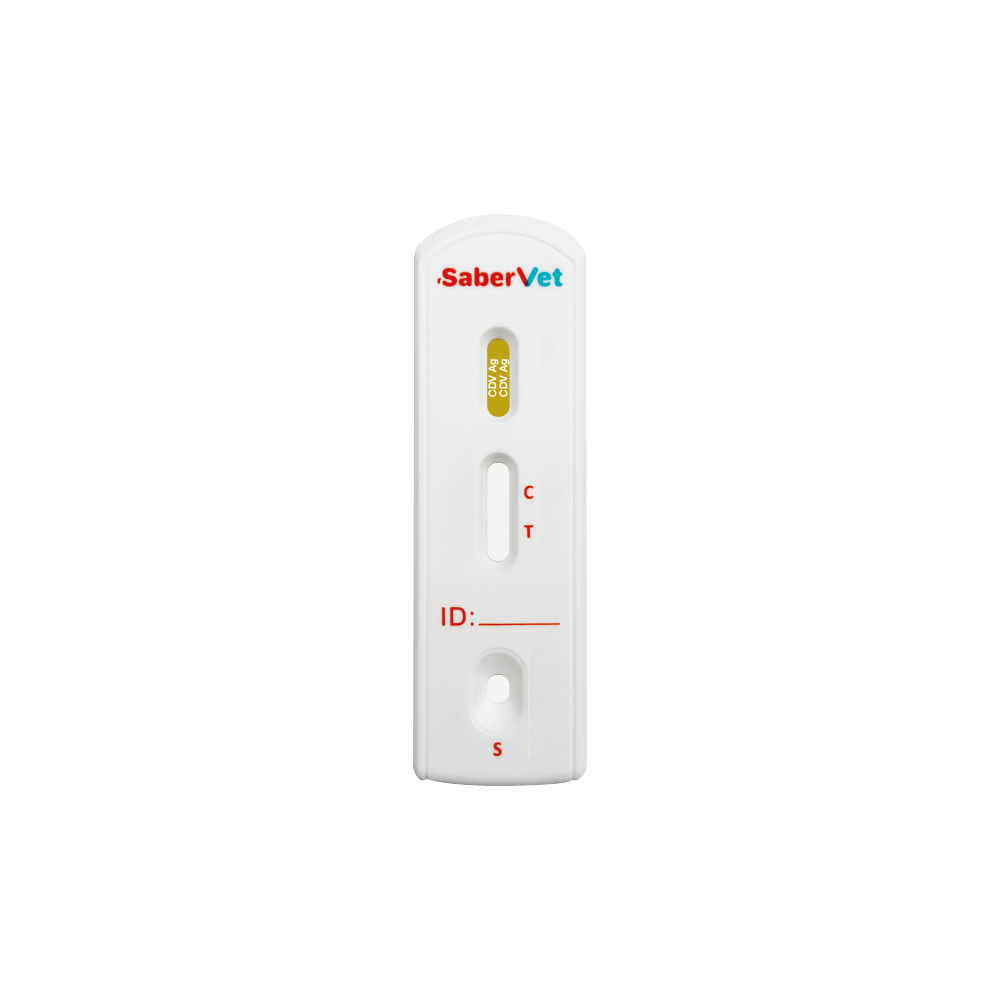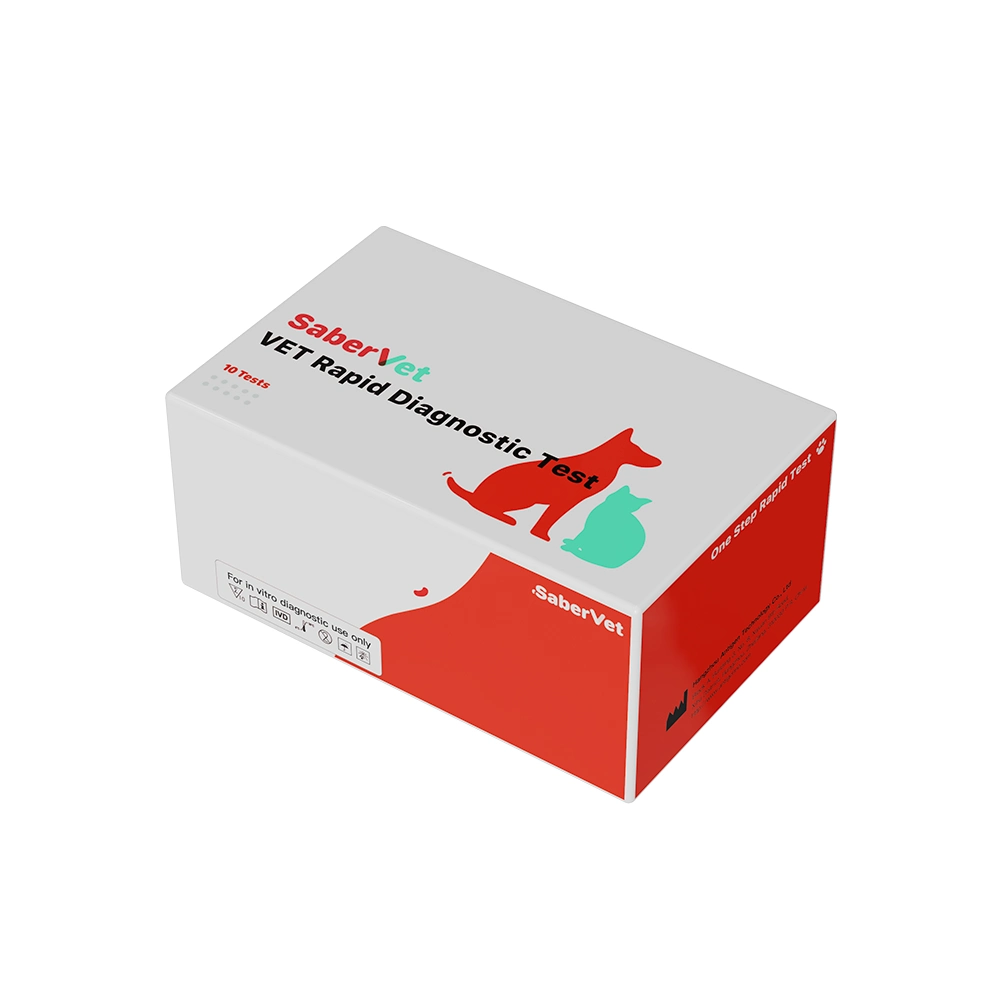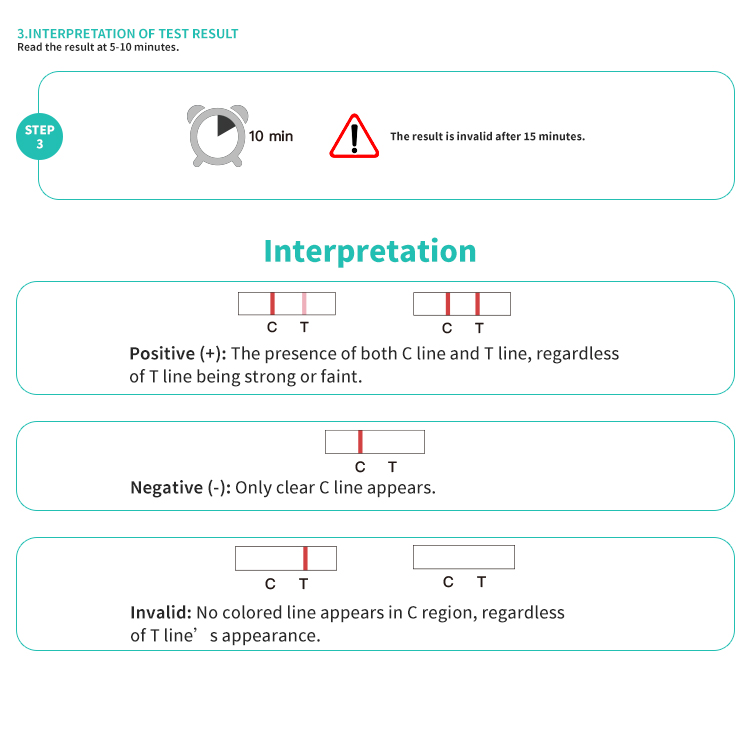Intended Use
Canine Distemper Virus Antigen Rapid Test is a lateral flflow immunoassay intended for the qualitative detection of specifific antigen from Canine Distemper virus (CDV) in eye,nasal flfluid or saliva sample. The test is useful for determination of CDV infection.
Contents
| Component | 10T/Box |
| Test device | 10 piece |
| Swab | 10 piece |
| Buffer | 10 piece |
Specifications
| Product name | Canine Distemper Virus Antigen Rapid Test |
| Brand Name | Sabervet |
| Model Number | 1091012410 |
| Specimen | Secretions |
| Application | Vet Health Diagnosis |
| Sensitivity | 99.80% |
| Specificity | 97.69% |
| Certificate | GMP & ISO9001 & CE |
| Assay Time | 10 Minutes |
| OEM&ODM | Available |
| Shelf Life | 2 Years |
Operation
Results
1.Pathological Introduction
Canine distemper is a disease among canine animals. According to the Animal Diseases Category by the Ministry of Agriculture and Rural Affairs of the PRC on January 15, 2020, canine distemper belongs to Category III Animal Diseases, which mainly infects canine animals. This disease is transmitted through direct contact with infected animals, airborne transmission, or food-borne infection. It is not a zoonotic disease.”
Canine distemper is a highly contagious infectious disease caused by the canine distemper virus among canines. It is characterized by strong contagion, a long course of the disease, and a high mortality rate. Once dogs contract canine distemper, they will initially exhibit symptoms of upper respiratory tract infection such as sneezing, coughing, nasal discharge, and eye discharge. Their temperatures usually rise to 39.5℃ or even 40.5℃.
As the disease progresses, excessive thickening of keratinization occurs on the soles of their feet and their paw pads may split open; at the same time, there are neural changes in their eyes and ears. The mental state of the dogs deteriorates and they may experience decreased thirst or even loss of appetite. In later stages, these initial upper respiratory tract infection symptoms develop into severe pneumonia symptoms which cause continuous coughing in dogs.
Dogs with severe neural symptoms may foam at the mouth and have convulsions resembling epilepsy episodes accompanied by persistent high fever and drowsiness/sleepiness. Additionally, these dogs may also suffer from gastrointestinal symptoms such as vomiting and diarrhea.
2.Distemper test for dogs
Currently, Canine Distemper Test are conducted using the following methods: immunofluorescence (IF), enzyme-linked immunosorbent assay (ELISA), gold immunochromatographic assay (GICA), nucleic acid hybridization technology, polymerase chain reaction (PCR), and loop-mediated isothermal amplification (LAMP).”
3.Therapeutic Regimen of CDV
Therapy for the initial stage of canine distemper
Intramuscular injection: Chinese Thorowax Root plus Antodin Injection, which has the ability to rapidly reduce body temperature. Canine distemper virus monoclonal antibody injection, either alone or in combination with concentrated plasma or 5 million hybrid interferon and genetically engineered thymosin, has demonstrated effectiveness in effectively killing and inhibiting the viruses.
Intravenous injection: Big Sugar (Ribavirin + Ceftriaxone + Qingkailing + Dexamethasone + Vitamin B1 Complex + Shuanghuanglian). Please note that Dexamethasone may lead to a notable reduction in lymphocyte cells, thereby significantly compromising the animal’s immunity to nonspecific infections.
It is important to emphasize that the effectiveness of these medications may vary depending on individual cases. It is strongly advised that diagnosis and prescription of these medications should only be carried out by professionals due to the potential risks involved. Improper use of these medications has resulted in significant fatalities among dogs.
Po: Angongniuhuang Pills + Vitamin B Complex Mistura Glycyrrhizae Composita
Chinese medicine treatment: radix isatidis 20g, Ophiopogon japonicus 8g, Pinellia ternate 7g, honeysuckle 10g, rheum officinale 8g, radix liquiritiae 7g, Forsythia suspensa 10g, Scutellaria baicelensis 8g, Gymsum fibrosum 40g, Astragalus membranaceus 10g, Tussilago farfara 8g, tuckahoe 10g, Atractylodes macrocephala 9g, radix bupleuri 6g.
Therapy for the later stage of convulsion
On frequent occasions of convulsions, please administer Chlorpromazine or Diazepam, as well as Oryzanol. Po: Angongniuhuang Pills should be ground and mixed with easily digestible liquids such as rice soup, bouillon, or Qingrejiedu oral liquid. (Please note that milk is indigestible for canines.) Then the blended liquids can be administered to the dog’s mouth using a syringe. Despite its low success rate in curing the dog, please never give up on treating it until the last moment. If he can live one more moment, please do not hesitate to continue treatment.
As Antigenne moves forward with its vision of revolutionizing animal disease detection, the launch of its brand, SaberVet, marks a significant milestone in the company’s journey. With six years of industry experience, Antigenne has built a solid foundation of knowledge and expertise in developing efficient and accurate diagnostic reagents. The creation of Itgen not only reinforces the company’s commitment to quality and innovation but also serves as a testament to its unwavering dedication to improving animal health and welfare.
Together, we can make a difference. Contact Antigenne now and let’s unlock the future of animal health.















